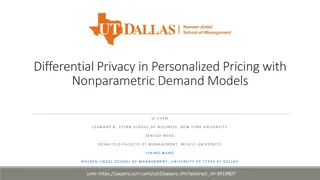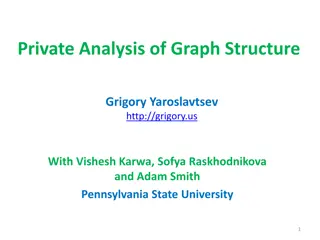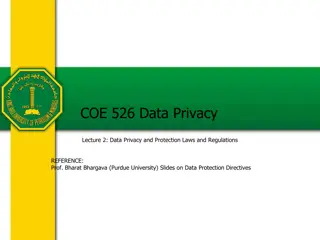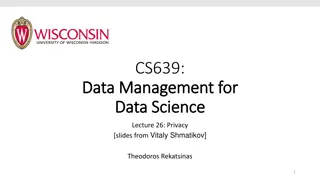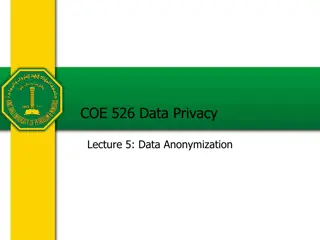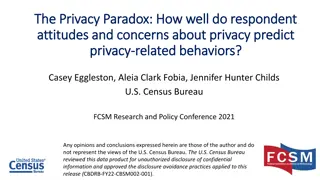AI, Privacy, and Data in Cybersecurity
Exploring the significance of data in the digital realm, this article delves into the interplay between AI, privacy, and cybersecurity. It examines the vulnerabilities of data, the role of AI in preventing cyber attacks through blockchain technology, and the impact of data usage on privacy. Key topics include the nature of data, cyberspace dynamics, data compromise, and AI's pivotal role in thwarting cyber threats.
Download Presentation

Please find below an Image/Link to download the presentation.
The content on the website is provided AS IS for your information and personal use only. It may not be sold, licensed, or shared on other websites without obtaining consent from the author.If you encounter any issues during the download, it is possible that the publisher has removed the file from their server.
You are allowed to download the files provided on this website for personal or commercial use, subject to the condition that they are used lawfully. All files are the property of their respective owners.
The content on the website is provided AS IS for your information and personal use only. It may not be sold, licensed, or shared on other websites without obtaining consent from the author.
E N D
Presentation Transcript
AI -Privacy and data Joseph Hayes Onur Celebi Liam Salazar-Endara Faisal Hamdan
Overview - - - - - - What is data? Introduction of the cyberspace How data can be compromised How AI can prevent cyber attacks with the use of blockchain The applications and advantages of AI in cybersecurity Limitations of AI in cybersecurity
Understanding the Nature of Data Figure 1 displays the 8 V s of Big Data (blockchainjournal.news, 2019) What is Data? Data has become such a vital component that it helps maintain the stability of the CNI of a given economy. Data can become Big Data when it is drawn from multiple sources.. Data platforms can be described as a means to bring data from a decentralized state to a centralized state. Cloud computing is where data can be stored and accessed over the internet of one s computer storage media
Into the Cyberspace A figurative environment where computers are able to communicate via an interdependent network such as the internet According to Martin C. Libicki, cyberspace is comprised of 3 layers: Physical, Syntactic and Semantic. Figure 2 displays a visual interpretation of cyberspace (icrc.org, 2020) Understanding cyberspace is key to understanding the principles of cybersecurity
Privacy can be compromised How is data used? - Data is used by companies to create consumer profiling - Recently privacy has been a significant aspect of people s lives and companies collect and store collected data to find out more information about the user to then use that information against them (Mazurek et al., 2019)
Cyberattacks and How AI with blockchain can prevent it Cyber attacks mainly occur due to a loss of data from a TTP Once a loss of data occurs many ransomware and phishing attacks occurs AI s prevention of cyberattacks: - The use of blockchain -which is composed of 3 parts Data Hash - If one block is tampered the following blocks become tampered and invalid AI will be necessary as there needs to be strict access protocol and secured data analysis so no data can be selective. Hash of previous block -
A purpose of AI in cyber security - There are regular cyber attacks with the objectives of industrial sabotage and data theft - Trying to keep a secure trustworthy environment plays a major key task and that is where AI should be considered. - Through deployment of AI algorithms, problems related to tremendous amount of information that are not possible to asses with limited resources can be assessed with limited resources
Advantages of AI techniques in Cyber Security - Two main applications of AI in cyber security are identification and authentication. Detection of malicious software using 2 methods: machine learning and classification techniques. AI algorithm in cybersecurity is used to create prediction, plan preventions and take actions - -
Limitations AI can be applied to many areas; however, there are some instances where AI is not as effective as the human brain. Unique features of the human brain are needed in some cases such as innovation and interpretation of decisions. Figure 13-1, Deploying AI in Enterprise
Limitations of AI in cybersecurity - - - - - Use of AI in too simple or too complex systems Obtaining enough and correct data for learning operation Costly and time consuming learning process Insoluble challenges may cause not to use AI Explainability of decisions
Summary 1) Companies should control what data is being used for AI and what this can lead to (Future prospects) 1) There are many applications of AI however, there are cases where there are limitations to AI which can be solved in the future which could lead to what 1) We are for the progression of AI in terms of privacy and data
References Benzid, I. et al. (2019) The Application of Artificial Intelligence for Cybersecurity in Industry 4.0. doi: 10.18420/inf2019_ws29. Hechler, E., Oberhofer, M. and Schaeck, T. (2020). Deploying AI in Enterprise. [Online]. Available at: https://link-springer- com.manchester.idm.oclc.org/content/pdf/10.1007%2F978-1-4842-6206-1.pdf Jahankhani, H., Kendzierskyj, S., Chelvachandran, N. and Ibarra, J. (2020). Cyber Defence in the Age of AI, Smart Societies and Augmented Humanity. Cham: Springer. [Online]. Available at: http://link.springer.com/10.1007/978-3- 030-35746-7(Accessed: 5 December 2021). Mazurek, Grzegorz, and Karolina Ma agocka. Perception of Privacy and Data Protection in the Context of the Development of Artificial Intelligence. Journal of management analytics 6.4 (2019): 344 364. Web. [Online] Available at: https://www.tandfonline.com/doi/abs/10.1080/23270012.2019.1671243 (Accessed: 5th December 2021)


